On March 22, Adobe announced a free public Beta version of Adobe Photoshop CS6 for trial. I use Adobe Photoshop on both a Mac and PC, but on the Mac Photoshop CS5 is locked to the top of the desktop window and when you open the program the background is transparent by default unlike that on the PC. The transparent background can be changed to the normal gray background by pressing the F key, however the inability to pull the program interface away from the top left desktop is disconcerting as I like to float open programs in separate windows so I can easily copy and paste between them. This feature has now been fixed on the Mac and Photoshop CS6 floats freely and it no longer has a transparent background. The other noticeable difference in Adobe Photoshop CS6 is that the interface has been made a darker charcoal gray color resembling that in Adobe Lightroom. However, if you like the lighter color of the older interface you can still return to it by selecting Edit>Prefs> Interface - and you can select darker or lighter interface colors. Below I highlight some of Photoshop CS6's Beta version new features which will become available for sale in a few weeks.

Above the New Photoshop CS6 Interface with darker gray color that gives it a more modern look

If you prefer the older light-gray color you can go into Photoshop Preferences and select different shades of gray.
The one puzzling feature about the new interface is that while Adobe Bridge has the same dark gray color, Adobe Camera RAW 7 doesn't. Also Camera RAW 7.0 does not have any new tabs added, however the sliders are now positioned in the center by default so users can add both positive and negative values which permits an even greater dynamic range.

Adobe Photoshop CS5\CS5 has been available in 4 different versions: 32 bit for computers with a maximum of 4 GB RAM, 64 bit for 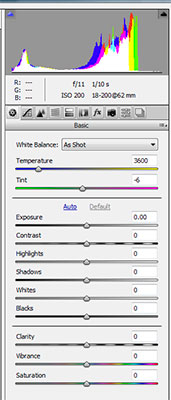 computers and operating system that supports more then 4 GB and also and Extended version that included 3D, movie editing, animation and video editing capabilities and several other tools for making measurements from images. The Beta version I am evaluating is the 64 bit normal version of Photoshop that does not have video editing. computers and operating system that supports more then 4 GB and also and Extended version that included 3D, movie editing, animation and video editing capabilities and several other tools for making measurements from images. The Beta version I am evaluating is the 64 bit normal version of Photoshop that does not have video editing.
Photoshop CS6 and Photoshop CS6 Extended will be part of the Adobe Creative Suite®, and Photoshop CS6 Extended will be part of Adobe Creative Cloud membership. Both Photoshop editions will also be available separately.
Cloud edition - US only, provides 20 GB of space and allows you to transfer your images among different devices including touch Apps. Pricing is estimated to be around $10\month and available in 2012. Read more about the Cloud on PC World web site.
At the right in Camera RAW 7 the sliders are centered so that you can add both positive and negative values for an even greater dynamic range. Also Adobe removed the recovery slider and replaced it with Highlights and Shadows slider so you can control each separately. The interface of Camera RAW 7 is still a light shade of gray.
NEW FEATURES in PHOTOSHOP CS6
1. Adaptive Wide Angle Lens correction
This new filter allows you to manipulate and fix distortions created by wide angle and fish-eye lenses. You do this by selecting Filter>Adaptive wide angle lens and then manipulate some of the controls and sliders.

Photograph of the Aurora taken with a Nikon 10 mm fish-eye lens at F2.8 - Prelude Lake, exposure 20 seconds, ISO 1600
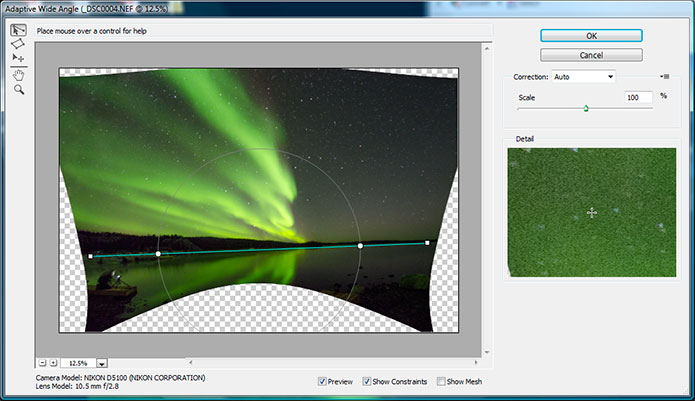
The image viewed in Adaptive Wide Angle allows me to select a line and drag it along the horizon to correct the distortions. The image can then be cropped and parts filled in using Content aware fill.

Image after correction and filling edges with Content Aware fill. Photographer Wayne Lynch is on the dock with his camera and tripod.
2. New Blur Gallery Filters include: Field blur, Iris Blur and Tilt-Shift blur.
These new filters allow you to control and manipulate parts of your image to make some regions appear to be out of focus. To access these filters you select Filter>Blur and you will see the three new blur features.

I t is possible to apply more then one of these filters to an image. Field Blur blurs the entire image, you need to protect an area by creating a selection around it first to prevent it from being blurred, the Iris Blur creates a circular selection which can be made elliptical and you can change the height and width of the selection and adjust the part of the picture you want to keep in focus and the part you want to blur. The Tilt-shift filter allows you to create a very narrow depth of field by blurring the background and foreground in a band (see below).
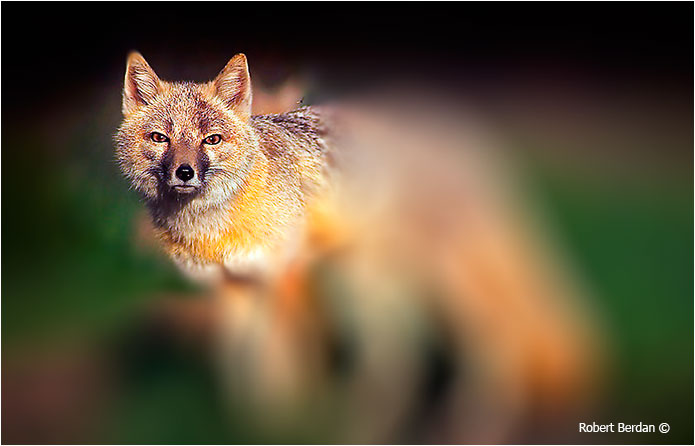
Above is a swift fox with a radial blur applied - only the head was protected in order to create an extremely shallow depth of field. This filter could also be useful in portrait photography or anytime you want to blurr the background quickly and easily.

Tuk - a captive wolf standing on some rocks in the Blaeberry Valley - shot with my 300 mm F2.8 lens and Nikon D300 Camera.
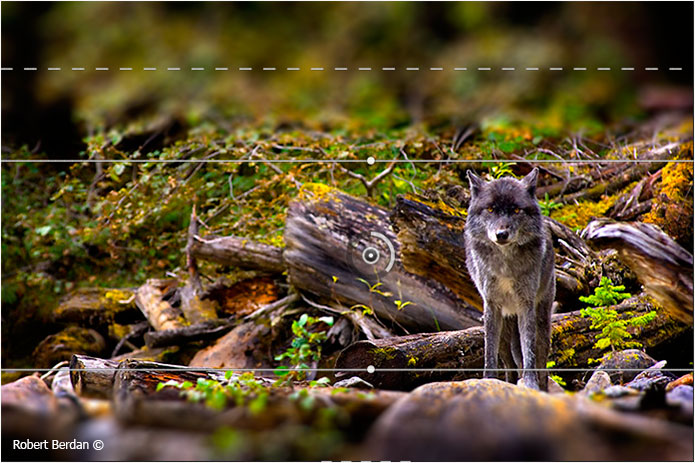
Above is a screen shot showing the use of the Tilt shift lens blur filter. The region that stays in focus and the blur radius can be controlled precisely. This is an amazing feature that used to require creating custom masks in earlier versions of Photoshop, but can now be applied quickly and allows the user to control the blur radius and blur fade regions of the image.
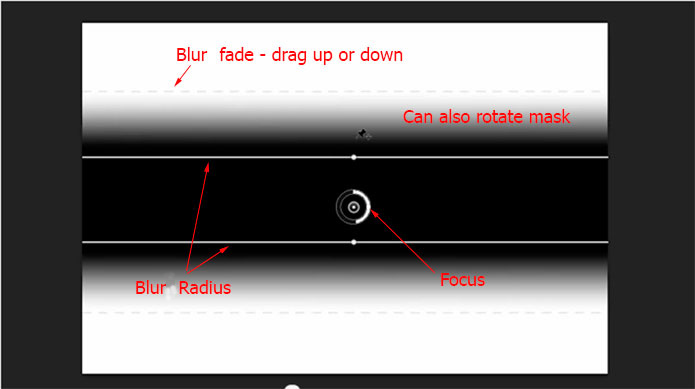
This image shows the blur mask and the various controls including focus (center ring you turn) the blur radius - you drag the lines up or down to define what stays sharp and the blur fade which controls how quickly the blur transition occurs. The mask can even be exported and used with other images.
3. Content Aware Move Tool
Content Aware fill was introduced in CS5 and it allowed photographers to draw a selection around a subject then select >fill with content aware an the subject magically disappeared as the program filled in the background. It was and still is magic. In CS6, Adobe added a the ability to select an object, move it elsewhere in the picture using Content Aware Move - the element moves and the original is was filled in to resemble the background.

Photograph of a Barren Lands Caribou - centered in the picture
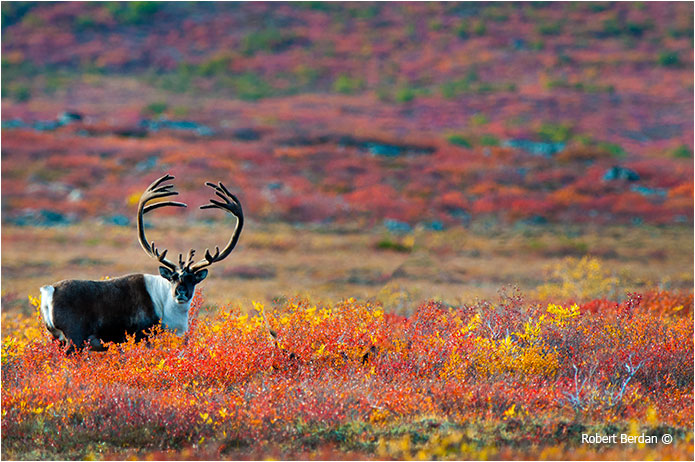
Caribou after I moved him with Content Aware Move tool (DM)
With fast moving wildlife, photographers often have the subject centered in the frame because that is where autofocus performs the best and it ensures we get sharp picture of the animal. Often to make the image better we crop the image so there is more space in front of the animal. Now with content aware move, photographers can adjust the position of the animal, person, tree or any element - afterwards. Some of you maybe thinking this cheating, and in a sense it is, but as a friend of mine would say - its not altering the biological integrity of the animal. Still in such cases I would indicated that the image has been digitally altered by including (DM) afterwards and most photo-contests and nature magazines consider such images to be digitally altered. One never has to do this - its just an option that can make the design of the image better.
4. Oil Painting Filter
In Photoshop CS5 Adobe added a variety of wet brushes that you could use to simulate an oil painting (see my article on Simulating painting with Adobe Photoshop). In CS6 they have added a new filter that makes it easier and quicker to convert your photographs into a simulated oil painting. Painters sometimes paint from photographs so why shouldn't photographers have the option to simulate paintings from their photographs - its just another way of presenting your images and I like it.

Autumn colors in Calgary

In CS6 Select Filter>Oil Paint - there are a variety of controls to alter the brush strokes and lighting.
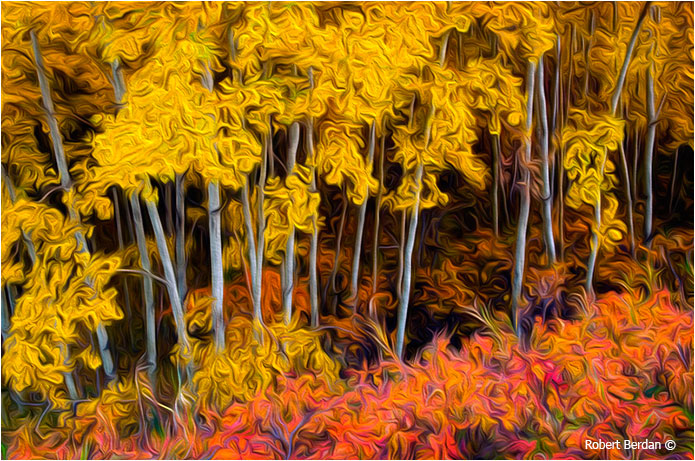
Autumn colors, the image now looks more abstract after applying the Oil Paint filter in Photoshop CS6.
5. Additional Features for Designers
I use Photoshop not only to work with photographs, but also to create web designs and two new features that are welcome are the ability to created dashed lines and add "lorem ipsum text" which is often used to show customers what type looks like in the layout. These features may not seem important if you are photographer, but they are if you create designs in Photoshop.

The ability to create dotted lines is now easier in Adobe Photoshop CS6. Also to add Lorem ipsum text Select >Type>paste lorem ipsum. Lorem Ipsum is simply dummy text used by graphic designers that allows customers to see what type looks like in their designs. Adobe has also added the ability to search and replace text. And finally, Adobe has added the ability to align objects on the stage and center them automatically a welcome feature that comes from Adobe Flash.
Photoshop Extended version has the ability to import images into a time line and convert the pictures into a movie. These features are reported to be enhanced in CS6, but I have not been able to test these features as they are not included in the Beta version. I will review them once they are available as many of the new DSLR cameras offer HD video, To see some of these new features you can watch the Russel Brown video available from the the link below. One feature I am hoping Adobe will include in CS6 is the ability to export movies to the streaming .FLV format. Currently I need to convert the output movies in Adobe's Media Encoder.

Ferns and Rose petals after applying CS6 Oil painting filter
For many photographers, Adobe Photoshop is a daunting program with more features than they will ever use. For this reason Adobe and other companies have created simpler programs like Adobe Photoshop Elements, Aperture, and Lightroom, however none of these programs offers the wide range of tools and flexibility that Photoshop offers. In fact there is no program at any price that offers more features to manipulate photographs and images. If you use Photoshop regularly then upgrading is definitely worthwhile. There are still features that I would like to see included in Photoshop. The first is to integrate software similar to Genuine Fractals now called Perfect Resize 7 that would allows us to resize image files with minimal loss of detail. To accomplish this in Photoshop today we need purchase the plug-in for Prefect Resize. Adobe is also starting to remove some useful features like the contact sheet and extract filter. In CS5 these filters could be added back in if you examined the DVD on which Photoshop came with and manually dragged the filters from the Goodies folder back into the appropriate folders. I suspect Adobe plans to eliminate these filters in future versions of Photoshop though I hope they don't. Otherwise, Photoshop continues to be the most powerful image editor on the planet and for those that want the ultimate in digital-darkroom control - Photoshop is still the best solution available at any price. Photographers that use Adobe Photoshop will have an advantage over those that don't. RB
Links & Resources
[ Top ]
|




 computers and operating system that supports more then 4 GB and also and Extended version that included 3D, movie editing, animation and video editing capabilities and several other tools for making measurements from images. The Beta version I am evaluating is the 64 bit normal version of Photoshop that does not have video editing.
computers and operating system that supports more then 4 GB and also and Extended version that included 3D, movie editing, animation and video editing capabilities and several other tools for making measurements from images. The Beta version I am evaluating is the 64 bit normal version of Photoshop that does not have video editing. 













